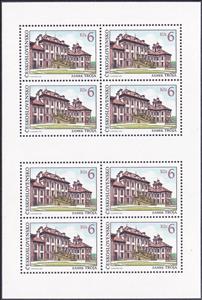Mini Sheet: Troja castle, Prague (Czechoslovakia 1992)
Troja castle, Prague (Czechoslovakia 1992)
22 July (Czechoslovakia ) within release Beauty of our country goes into circulation Mini Sheet Troja castle, Prague face value 8*6 Czechoslovakian koruna
| Mini Sheet Troja castle, Prague in catalogues | |
|---|---|
| Michel: | Mi: CS 3126KB |
| POFIS: | POF: CS 3018PL |
Mini Sheet is vertical format.
Also in the issue Beauty of our country:
- Stamp - Troja castle, Prague face value 6;
- Stamp - Statue of St. Martin in Bratislava face value 7;
- Stamp - Lednice castle face value 8;
- Mini Sheet - Statue of St. Martin in Bratislava face value 8*7;
- Mini Sheet - Troja castle, Prague face value 8*6;
- Mini Sheet - Lednice castle face value 8*8;
Mini Sheet Troja castle, Prague it reflects the thematic directions:
Architecture (Latin architectura, from the Greek ἀρχιτέκτων arkhitekton "architect", from ἀρχι- "chief" and τέκτων "builder") is both the process and the product of planning, designing, and constructing buildings and other physical structures. Architectural works, in the material form of buildings, are often perceived as cultural symbols and as works of art. Historical civilizations are often identified with their surviving architectural achievements.
he Baroque or Baroquism is a Western style of architecture, music, dance, painting, sculpture, poetry, and other arts that flourished from the early 17th century until the 1750s. It followed Renaissance art and Mannerism and preceded the Rococo (in the past often referred to as "late Baroque") and Neoclassical styles. It was encouraged by the Catholic Church as a means to counter the simplicity and austerity of Protestant architecture, art, and music, though Lutheran Baroque art developed in parts of Europe as well
A building or edifice is a structure with a roof and walls standing more or less permanently in one place, such as a house or factory. Buildings come in a variety of sizes, shapes and functions, and have been adapted throughout history for a wide number of factors, from building materials available, to weather conditions, to land prices, ground conditions, specific uses and aesthetic reasons. Buildings serve several needs of society – primarily as shelter from weather, security, living space, privacy, to store belongings, and to comfortably live and work. A building as a shelter represents a physical division of the human habitat (a place of comfort and safety) and the outside (a place that at times may be harsh and harmful).
A castle (from Latin: castellum) is a type of fortified structure built in Europe and the Middle East during the Middle Ages by European nobility. Scholars debate the scope of the word castle, but usually consider it to be the private fortified residence of a lord or noble. This is distinct from a palace, which is not fortified; from a fortress, which was not always a residence for nobility; and from a fortified settlement, which was a public defence – though there are many similarities among these types of construction. Usage of the term has varied over time and has been applied to structures as diverse as hill forts and country houses. Over the approximately 900 years that castles were built, they took on a great many forms with many different features, although some, such as curtain walls and arrowslits, were commonplace.




